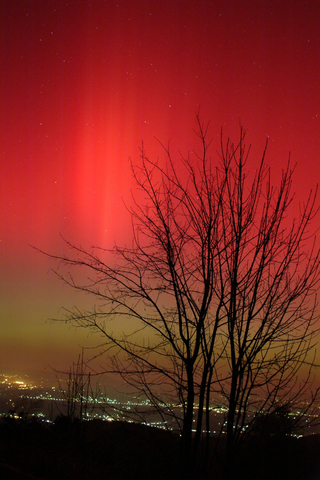(Please be patient when images at bottom of this page are loading)
Plots for 29th and 30th of October. Never before saw Kiruna magnetometer tilt of -3800 nT, as it was 30th Oct at 20 UTC (no doubt cycle 23 maximum).
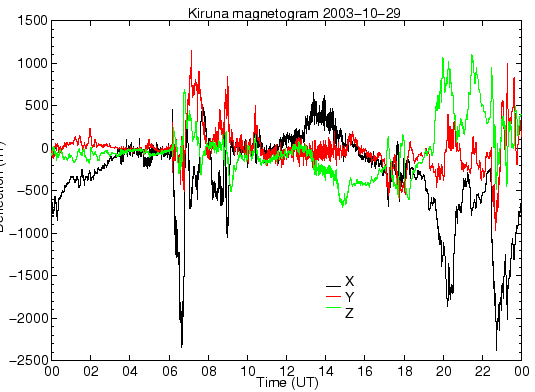
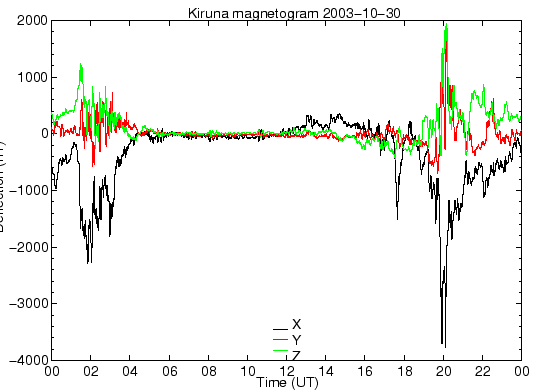
After long period of solar inactivity new spotted region (numbered as 10484 by SEC) rotated into view at the northeast limb on October 17. The region developed extreme quickly and soon got enormous penumbra containing very strong magnetic delta structure - one of the largest during cycle 23. 19th of Oct produced 1st X1.1 flare, unfortunately not geoeffective. At the same time activity at sun's far side (M9.9 flare) was showing that new spotted region will appear at visible part of solar disk soon.
It was just a beginning of sudden solar activity. New spot region 10486 appeared at solar disk 23rd Oct and same day produced major X5.4 flare followed by X1.1 flare and few M-class events (max M7) - a bit to early to be geoeffective. Both spotted regions continued with extreme activity. 10486 produced a major long duration X1.2 event, and 10484 X1.2 25th of Oct. Region 10486 developed to largest spot group in cycle 23 (larger than planet Jupiter), and finally, 28th of Oct, after major M8.4 flare, produced super flare peaked X17.2 level, second largest flare during cycle 23. The event has been associated with an enormous and extremely fast earth directed CME. Solar flux measured at on 2.8 GHz was 291.7, what is a new high for solar cycle 23.
29th Of Oct, at 06 UTC, huge solar storm has impacted the Earth, just 19 hours after leaving the sun. This is probably the second fastest solar storm in historic times, only beaten by the solar storm in the year 1859 which spent an estimated 17 hours in transit (legendary perfect solar storm with northern lights in Rome, Havana and Hawaii).
29th of Oct at evening, when geomagnetic storm was in full progress, region 10486 produced another X10 flare, with major, earth directed CME. Extreme storm was extended one day more, reaching during night 30th / 31st Oct even more severe levels as day before.
In the meantime, other parts of sun were extremely active as well. Region 10488 produced X2.7 and X3.9 flare, but not geoeffective. Source of both geoeffective flares, region 10486 continue with activity and produced major X8.3 flare with large CME 2nd of November, but without significant influence to earth. There was never during cycle 23 so many major flares in such short period.
Finally, 4th of Nov 10486 produced greatest explosion ever recorded in solar system, X28 superflare and CME with estimated speed about 2500 km/sec. At that time region was at southwest limb and most of ejected material missed the earth. Region 10486, before disappeared from sun's face, produced 3 events which are on the top-list of flares ever recoded: 1st position, greatest, "mother of all flares", X28 superflare, 3rd pos., X17.2 flare, and 10th pos., X10 flare. Large CME's produced by 2 of them hit the earth, and the biggest one, unfortunately (or luckily, depending on point of view) missed. The three giant sunspots unleashed eleven X-class flares in only fourteen days, equalling the total number observed during the previous twelve months.
Next days sun was almost spotless, period of activity was over. How long ? It is hard to answer on such question. Activity at sun's far side is showing that two giant spots are still active, but they will probably lost most of its potential when they rotate to the visible side again. Doesn't matter this event may look like surprise, sunspot counts averaged over many weeks are still declining as predicted, and we are on course for a solar minimum in 2006. Statistics are showing tendency that biggest flares occurs after solar maximum, on the downslope toward solar minimum. Similar happened in a few cycles before this one. Cycle 23 is still in the phase when most of spots occurs closer to solar equator than solar poles (it is visible from so called "butterfly diagram"), and that's increasing chances for geoeffective flares. Activity of this cycle is not definitive over, but, if new similar event to this one will occur, this is question none can answer.
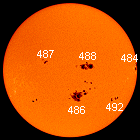
Below: giant spot group 10486, source of both geoeffective flares.
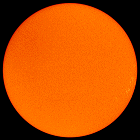
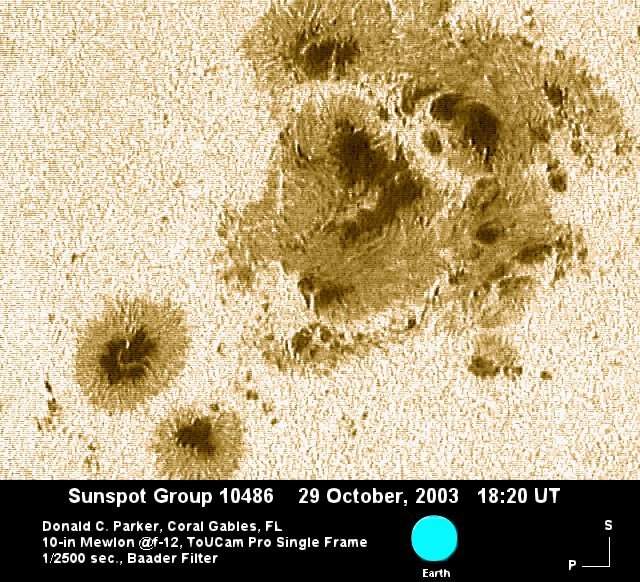


Snow at LASCO image is result of extreme radiation.
Below: X17.2 flare and GOES X-ray plot.
Radiation was more than hour over X1-level and almost 4 hours at M-levels.
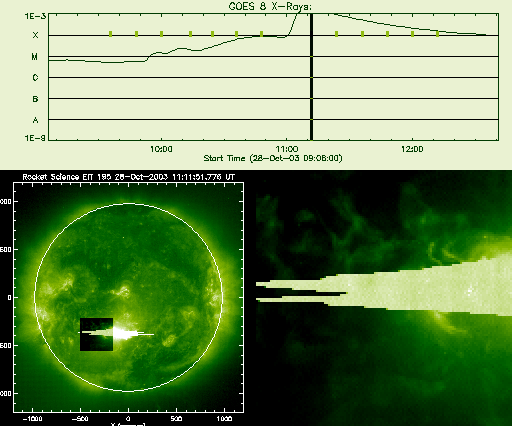
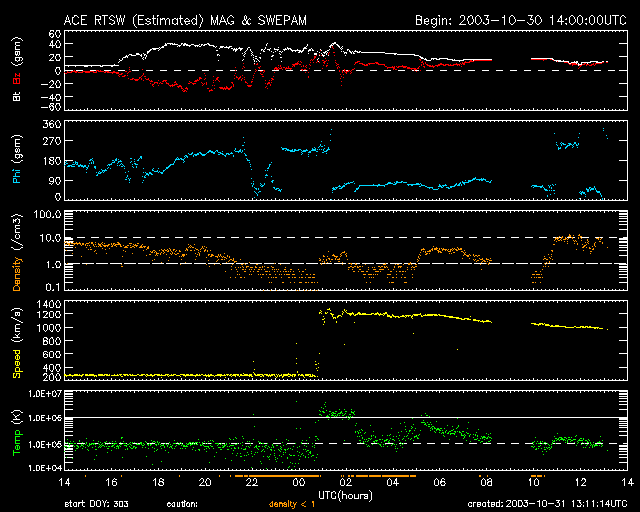
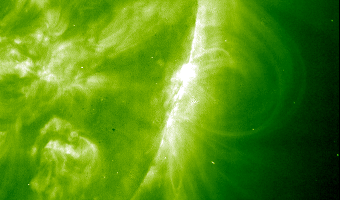

Comment added 21st of November 2003:
Another severe storm surprised even experts 20th / 21st of November. Former spot group 10484, renumbered by SEC as 10501 was still capable for M-flares after one rotation cycle, and produced 18th of Nov two M5 flares in short period, both with faint CME's. Impact was predicted for 20th of Nov, and most optimistic forecast was minor to major storm not reaching one tenth of the event from 30th of October. But, after impact at 08 UTC 20th of Nov, storm reached severe magnitude in the afternoon hours (K8 - K9), continued to early morning, triggering radio aurora as south as in I4 and I5. ACE impact speed was about 780 km/s and falling during event (550 km/s at 20 UTC), but IMF was southward all the time, reaching extreme value of
The greatest surprise was intensity of visual aurora: in JN86 aurora started about 19 UTC, as a intensive white light on the northern horizon. Soon aurora was spread over a half of the sky, visible in white, green and red colours from the west, over the north, to the east, with the beautiful moving green stripes and curtains almost in the zenith. During cycle 23 we saw a few auroras before (incl. 30th of Oct), but only as purple twilight low on the northern sky. Such a spectacular 5 hours of sky lightshow I saw never before, it was certainly strongest aurora in the last 50 years (or may be ever seen in JN86). As aurora was advancing, it was turning to dominantly red colours, and after 00.30 UTC it was still visible as a purple pulsing at southern horizon (azimuth 150 degrees)!!! Visual auroras were reported from Spain, Greece and Turkey as well.
It seems this event is rather result of a lucky circumstances than some extreme solar activity. On my opinion, reason for such severe storm is probably combined effect of two CME's, second faster than first one. When one CME is reaching another, it is sometimes resulting with extreme impact effects to Earth's magnetosphere. Similar phenomena we already saw once in the past during this solar cycle.

